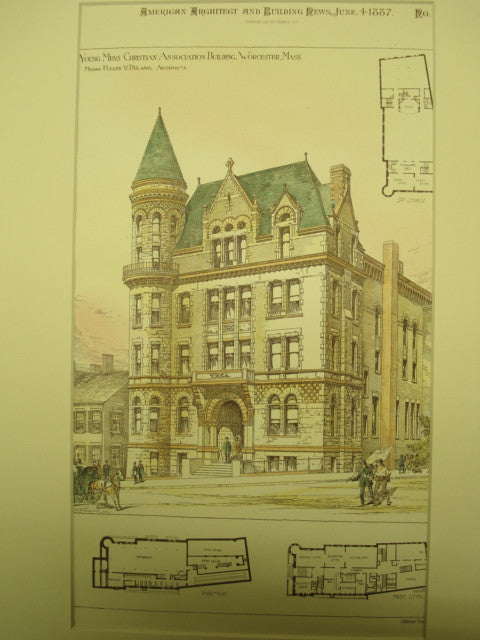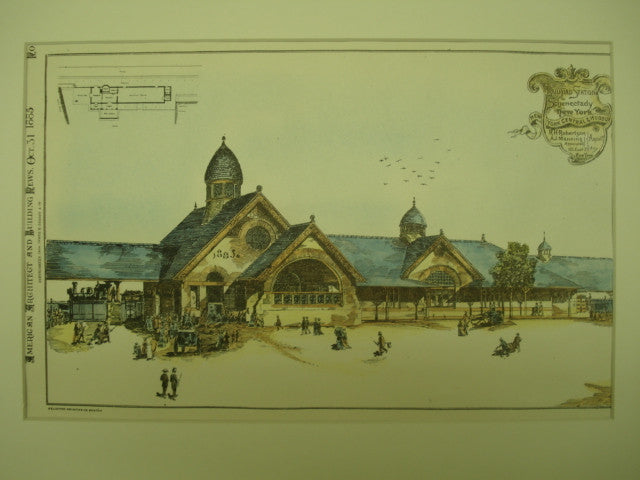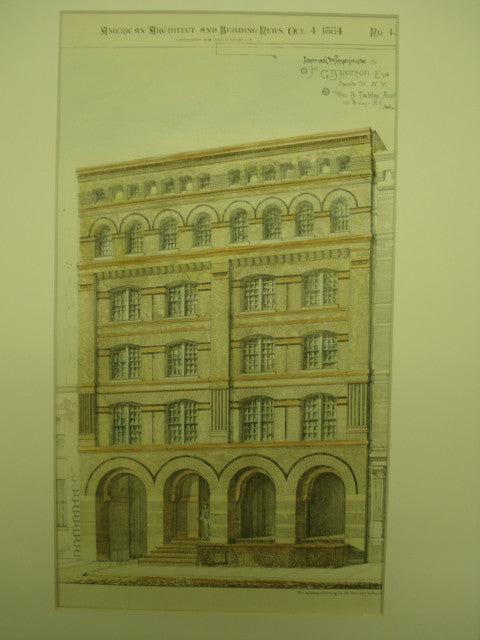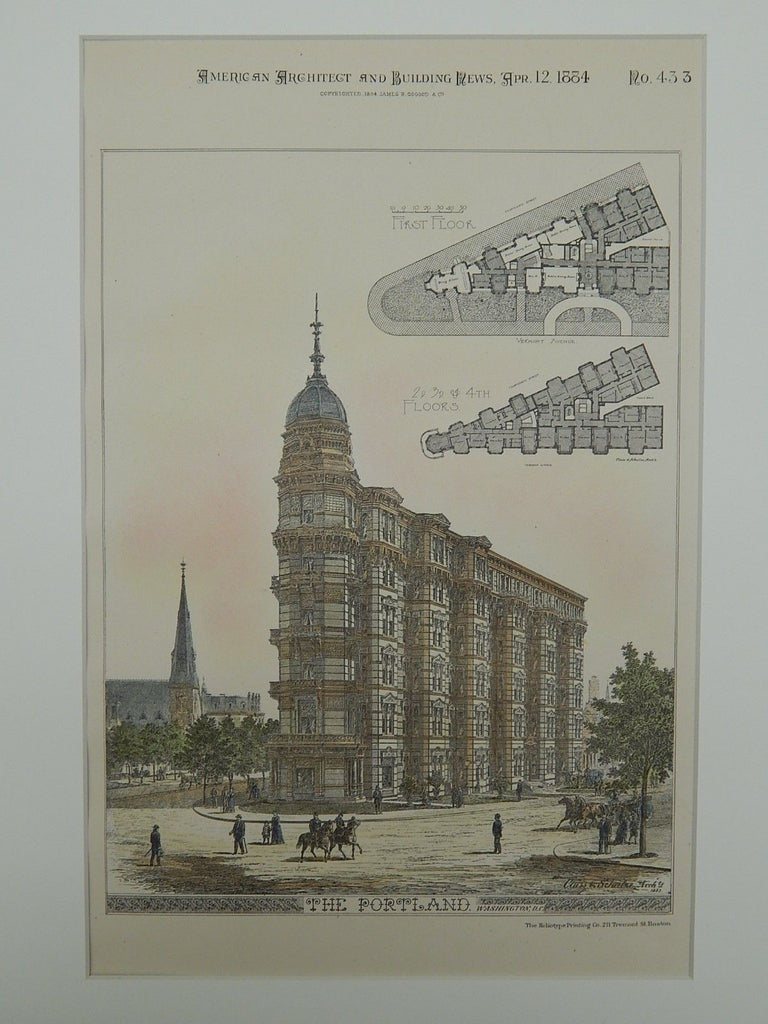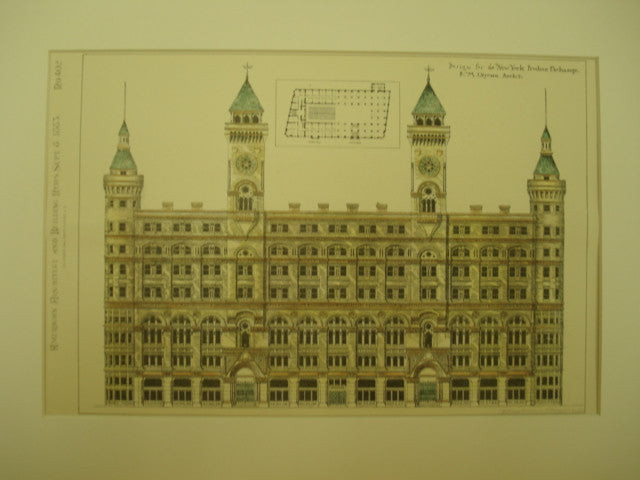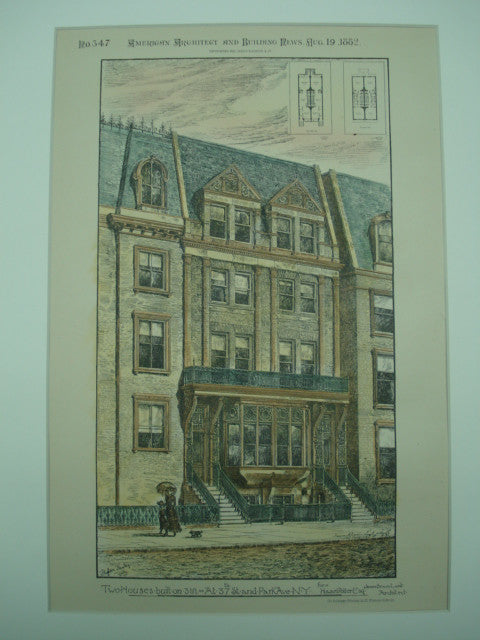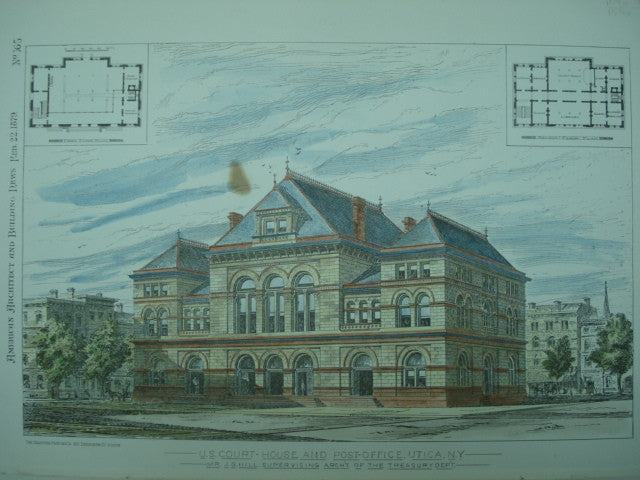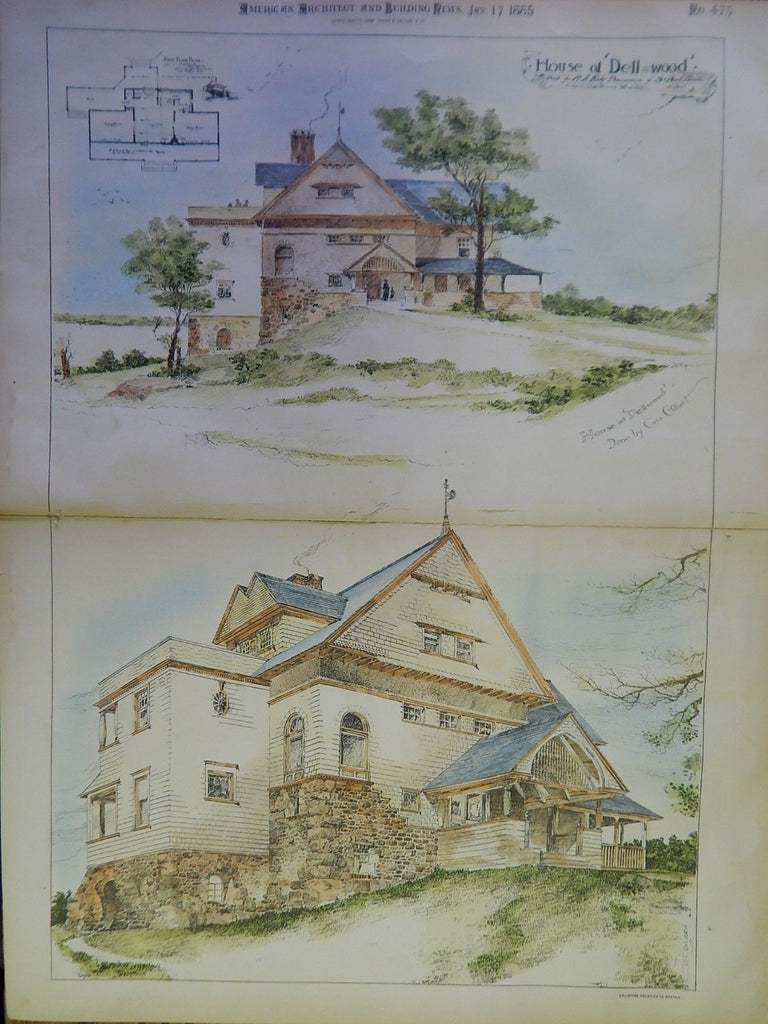News
Libraries and Schools in 1888 August 31 2015
This is the thirteenth installment in our series of posts comparing significant events from a year in United States history with a few of our unique architectural plans from the same period. 1888, the topic of this installment, subsequently marks the thirteenth year of the American Architect and Building News' existence.
Click on the pictures to find the plans below in our store!
The Library of Congress was first conceptualized by James Madison in 1783, but didn't begin to resemble the majestic research facilities we know now until over a century later. The first of these buildings to be constructed was Thomas Jefferson Building in Washington, DC. Though construction on the building didn't begin until 1890, by 1888, plans were already in full-swing for the building. Below is an early original of Paul J. Pelz and John L. Smithmeyer's plans for the Jefferson Building, which looks fairly close to the final version of the building that we know today.
On January 12, 1888, the Midwestern states were hit by an extreme blizzard seemingly out of nowhere. Dubbed the "Schoolhouse Blizzard", it sprang up on the afternoon of a relatively warm day and hit with such severity that 235 people were killed, many of them children on the way home from school. In Minnesota, one of the states hit worst by the blizzard, this hotel at Little Falls would have been right in the epicenter of the storm. It's beautifully detailed plan was designed by architects Gilbert & Taylor.
Fine Dining and Athletics in 1887 August 28 2015
This is the twelfth installment in our series of posts comparing significant events from a year in United States history with a few of our unique architectural plans from the same period. 1887, the topic of this installment, subsequently marks the twelfth year of the American Architect and Building News' existence.
Click on the pictures to find the plans below in our store!
In New York City during the mid-nineteenth century, the Delmonico name was synonymous with fine dining throughout the nation. The family owned a number of restaurants throughout the city and was best known for pioneering the forever imitable Delmonico steak. Below is an 1887 plan for a new Delmonico's Restaurant at 341 Broadway in New York City, designed by prominent architect James Brown Lord. Though it is unclear whether this location came into existence, seeing Lord attached to the Delmonico name provides an interesting look at the influence the Delmonico family and their food had over the city.
The Young Men's Christian Association was founded by George Williams in mid-nineteenth century London. Williams was concerned about the lack of healthy activities for young men living in cities in the period soon after the industrial revolution and sought to provide new access for them. By the 1880s, the YMCA had spread throughout the Western world, providing opportunities for sportsmanship and athletic contests, as well as promoting evangelical Christian services. This 1887 plan for the Young Mens Christian Association Building in Worcester, Massachusetts designed by Fuller & Delano exemplifies the popularity and reach of the association in such a short amount of time. And this was just the beginning of the YMCA's storied history.
The Nation Shakes in 1886 August 26 2015
This is the eleventh installment in our series of posts comparing significant events from a year in United States history with a few of our unique architectural plans from the same period. 1886, the topic of this installment, subsequently marks the eleventh year of the American Architect and Building News' existence.
Click on the pictures to find the plans below in our store!
In 1886 a general strike began among the workers of the United States to fight for better working rights within the nation. It culminated with the Haymarket affair at Haymarket Square in Chicago, Illinois. Originally a peaceful rally in support of those striking, the situation took a turn for the worse when someone threw a bomb towards the police line watching over the protests. Seven police officers and four citizens were ultimately killed in the resulting chaos. This Store Building on State St. for Ben Bagaman would soon be built near to the square, and its workers would soon be rewarded with the eight-hour workday fought for by their fellow workers. It was designed by Addison & Fielder.
On August 31 of 1886, an earthquake of magnitude 7.6 hit the coast of southeastern South Carolina, right near Charleston. Over 2,000 buildings in the area were destroyed and 60 lives were lost. Before this earthquake, almost no seismic activity was recorded in the history of the area, though it sits right near an active tectonic region. The St. James' Goosecreek Church in Charleston, South Carolina, designed by an unknown architect, likely was built after the earthquake hit the region. However, one would hope that all new buildings built in the area after the event would be reinforced to prevent such massive damage in the future.
The Nation Develops in 1885 August 24 2015
This is the tenth installment in our series of posts comparing significant events from a year in United States history with a few of our unique architectural plans from the same period. 1885, the topic of this installment, subsequently marks the tenth year of the American Architect and Building News' existence.
Click on the pictures to find the plans below in our store!
On February 16 of 1885, the first edition of the Dow Jones Industrial Average was published by Charles Dow, a major step in the development of the United States' economy. The average originally represented the dollar average of 14 of the most important United States stocks, while today it represents the average of 30. The original average consisted of 12 railroads, including the New York Central railroad. A beautiful station for the New York Central, as well as the Hudson River Railroad in Schenectady, New York is presented below, designed by R. H. Robertson & A. J. Manning.
In Chicago, Illinois, the tallest building in the world was completed in 1885. The Home Insurance Building was ten stories tall and the world's first skyscraper. It was the king for four years, until being passed by the Auditorium Building in 1889, also built in Chicago. This plan for the Adams Express Building for A.J. Cooper & Jas D. Carson from 1885 in Chicago only has eight stories, but was sure to tower over the rest of the city when its Geo. H. Eabrooke design was completed.
Workers Win in 1884 August 21 2015
This is the ninth installment in our series of posts comparing significant events from a year in United States history with a few of our unique architectural plans from the same period. 1884, the topic of this installment, subsequently marks the ninth year of the American Architect and Building News' existence.
Click on the pictures to find the plans below in our store!
On May 1 of 1884, the first recognized May Day, the Federation of Organized Trades and Labor Unions in the United States declared the eight-hour workday the mandatory maximum for workers in the United States (without being awarded overtime pay). Though the United States government didn't enact any laws around this issue until about 30 years later, this was an important step in securing workers' rights in the country. The workers at this Leather Workhouse for G. B. Horton in New York, New York would have been especially grateful hearing about this decision. The building was designed by Wm. B. Tubby.
After years of planning and construction, the Washington Monument in Washington, DC was finally completed in December of 1884. Designed by Robert Mills, it is not only the world's tallest obelisk, but the world's tallest stone structure of any shape. Located a few blocks north of the monument, this design for the Portland Building by Cluss & Schulze came out in April of the same year. Be sure to also take a look at our various plans for the Washington Monument here.
Times Change in 1883 August 19 2015
This is the eighth installment in our series of posts comparing significant events from a year in United States history with a few of our unique architectural plans from the same period. 1883, the topic of this installment, subsequently marks the eighth year of the American Architect and Building News' existence.
Click on the pictures to find the plans below in our store!
On May 24 of 1883, the Brooklyn Bridge in New York City opened to the public after 13 years of construction. The bridge connected Manhattan and Brooklyn, stretching over a mile across the East River. Just six days after it's opening, a stampede on the bridge occurred over rumors of the bridge's collapse, causing 12 people to be crushed in the resulting chaos. This design for the New York Produce Exchange by R. M. Upjohn would have been located nearby in Manhattan, and any Brooklyn or Long Island producers would now have an easy way to reach it and sell their wares. Upjohn is well-known for his Gothic Revivalist style, spurring the movements popularity in the country.
November of 1883 brought along the founding of universal time zones throughout the United States. The idea was put forth by the U.S. and Canadian railroad companies as a better means for planning arrivals and departures for their trains. Though the boundaries for the zones looked much different than they do today, the establishment of these ended much confusion throughout the nation with regard to scheduling. This combination United States Court House and Post Office designed by Jas. G. Hill in Quincy, Illinois would have benefited much from the zones' creation, as the Postal Service would have had a much easier time keeping their schedule.
Electricity Begins and Poetry Ends in 1882 August 17 2015
This is the seventh installment in our series of posts comparing significant events from a year in United States history with a few of our unique architectural plans from the same period. 1882, the topic of this installment, subsequently marks the seventh year of the American Architect and Building News' existence.
Click on the pictures to find the plans below in our store!
Thomas Edison continued to shape the nation's history in 1882. To add to his list of ever-growing achievements, he established the world's first commercial electric power plant, giving electricity to an entire square mile of lower Manhattan. These two houses, at 37th Street and Park Avenue for Howard Potter, might have not been in that original lighted area, but were sure to soon feel the full effects of Edison's genius. They were designed by the master of the Beaux-Arts style, James Brown Lord.
On March 24, 1882, Henry Wadsworth Longfellow succumbed to peritonitis in his Cambridge, Massachusetts home in the company of his close family. The celebrated poet and Harvard professor was best known for his works The Song of Hiawatha and Evangeline, though he was also the first American to produce a translation of The Divine Comedy by Dante Alighieri. The First Baptist Church of Cambridge, Massachusetts (whose interior is shown below) would have been quite near Longfellow's home, though Longfellow did not attend himself. It was designed by Hartwell & Richardson.
The Nation Experiences Tragedy in 1881 August 14 2015
This is the sixth installment in our series of posts comparing significant events from a year in United States history with a few of our unique architectural plans from the same period. 1881, the topic of this installment, subsequently marks the sixth year of the American Architect and Building News' existence.
Click on the pictures to find the plans below in our store!
While 1880 was an election year in the United States, the newly elected president James A. Garfield wasn't inaugurated until early 1881. On the night of March 5, 1881, the National Museum in Washington, DC held an "Inaugural Reception & Promenade Concert" to celebrate the event, as depicted in beautiful detail on the plan below. The museum, designed by Cluss & Schultze, hosted a number of important political events for the nation's capital. However, the night's celebrations would prove to be short lived. Garfield would be shot in July of 1881 at the Baltimore and Potomac Railroad Station in Washington, D.C and succumb to the wound's infection in September of the same year.
On September 5, 1881, the Thumb peninsula of Michigan was the victim of one of the worst fires of the period. Over a million acres were destroyed and 282 people were killed in less than a day. The fire was caused by a combination of factors, the most important being the era's damaging logging techniques that took place throughout the area. A short ways south in Detroit (which was luckily just out of the fire's range), this gorgeous residence was designed by prominent architects Mason & Rice for an unknown client.
Gilded Age Progress in 1880 August 12 2015
This is the fifth installment in our series of posts comparing significant events from a year in United States history with a few of our unique architectural plans from the same period. 1880, the topic of this installment, subsequently marks the fifth year of the American Architect and Building News' existence.
Click on the pictures to find the plans below in our store!
1880 in the United States marked the peak of the so-called "Gilded Age" of the nation's history. This period was characterized by an appearance of a shining gold lining masking a number of serious social problems persisting through the country. For instance, while wages within the United States were significantly higher when compared to those in Europe, massive numbers of European immigrant arriving in the U.S. meant that many lived in extreme poverty. Elsewhere, the American South was still trying to return to the prosperity it saw just before the Civil War. These furniture designs by Edward Dewson & S. N. Small in Boston, Massachusetts provide a good example of the art seen throughout the Gilded Age: ornate and beautiful, but reserved for only the wealthiest of citizens.
Though he had been hard at work for some time before 1880, the year would mark a big breakthrough for American inventor Thomas Edison. The Wizard of Menlo Park, New Jersey had just patented his remarkable phonograph machine in the few years prior, and immediately set his sights on broader horizons. In 1880, he performed the first test of his electric railway idea, which, after much development, would lead to a public transportation revolution and change railway transportation all over the world. In nearby Orange, New Jersey, architects Silliman & Farnsworth designed this Music Hall (also built in 1880) which might have entertained Edison during one of his well-deserved breaks.
US Goes on the Gold Standard in 1879 August 10 2015
This is the fourth installment in our series of posts comparing significant events from a year in United States history with a few of our unique architectural plans from the same period. 1879, the topic of this installment, marks the fourth year of the American Architect and Building News' existence.
Click on the pictures to find the plans below in our store!
1879 brought into the effect the Specie Resumption Act within the United States. For the first time since before the Civil War, the value of paper currency within the nation became equal to that of gold. This led to more faith in the American economy by consumers, and a willingness to spend their money in stores, such as these on Devonshire and Summer Streets in Boston, Massachusetts. These were designed by notable Boston architects Cummings & Sears and can be found in wonderful detail on the plan below.
Frank Winfield Woolworth founded the first of what would become numerous of his famous Woolworth stores in 1879. Located in Utica, New York, these revolutionary new stores sold items at the firm price of five- and ten-cents apiece; a new idea at the time, as previous vendors usually would sell their items at prices determined by haggling. These stores created the shopping experience we're used to today, so much so that their "Five-and-Dimes" name still persists in the common American vernacular. The plan below depicts the United States Court House and Post Office in Utica, New York, designed by J. G. Hill in 1879. This building would have been just down the street from the first of Mr. Woolworth's soon-to-be famous stores.
Newspapers and Explosions in 1878 August 07 2015
This is the third installment in our series of posts comparing significant events from a year in United States history with a few of our unique architectural plans from the same period. 1878, the topic of this installment, marks the third year of the American Architect and Building News' existence.
Click on the pictures to find the plans below in our store!
In January, Yale University students found The Yale Daily News. The News is still celebrated today as the oldest daily college newspaper within the country, but not without contest. A number of colleges, including Harvard, Rutgers, Dartmouth, California and Cornell, all lay stake to their own claim of the oldest newspaper. However, Yale's tends to be the most frequently recognized as the holder of the crown. Regardless, newspapers were how the majority of Americans stayed on top of things at the time, as evidenced by this 1878 building for the Cincinnatti Gazette by an unknown architect. Be sure to also take a look at our collection of Yale plans.
May of 1878 saw a tragedy in the midwest of country. The Washburn "A" Mill, located on the west bank of the Mississippi River in Minneapolis, Minnesota, exploded, killing 18 workers. A loose spark caused the highly flammable floating flour particles to combust, creating a gigantic explosion that leveled the mill. Today, the ruins of the mill still stand and can be explored via a museum built around them. Nearby, this house at Dellwood for Mr. A Kirby Barnum in Saint Paul, Minnesota was built based on a design by the legendary Cass Gilbert.
U.S. Architecture Ramps Up in 1877 August 05 2015
In the United States, 1877 marked the end of the Reconstruction Era, which brought the South back into the fold in the decade following the Civil War. However, the end of this era didn't hinder the advance of architectural progress in the United States. In it's second year, the American Architect and Building News continued to provide architects with all of the significant happenings within their industry.
Click on the pictures to find the plans below in our store!
In June, cadet Henry Ossian Flipper became the first African American graduate from the United States Military Academy in West Point, New York. October brought more to West Point, when General George Armstrong Custer was laid to rest at the Academy following his death at Little Big Horn the previous year. Remembrance toward the nation's fighting men became more popular, as evidenced by this Soldiers' Memorial Chapel in Akron, Ohio, designed by Frank O. Weary.
July of 1877 brought riots by Baltimore and Ohio Railroad railroad workers in Baltimore, Maryland. This would lead to a strike and more rioting by their fellow railroad workers in Pittsburgh, Pennsylvania. In St. Louis, another worker's rebellion established a Communist government for a short time before the newly appointed President Hayes decided to call in the nation's armed forces to quell the uprising. In more tranquil areas of the industry, this railroad station was built in Providence, Rhode Island. It's design was handled by premier Boston architects Peabody & Stearns.
Architecture Comes of Age in the US in 1876 August 04 2015
The American Architect and Building News, which began in 1876, signaled that architecture was becoming a full fledged profession. When looking at buildings built in specific years, it's interesting to find out what was happening at the time. In this series of postings, we will note some of the interesting events that took place while some of the buildings that appear on our website were being built. In 1876, for example, the first electric dental drill was patented, the first recorded hockey game was played in Montreal and the first shutout in baseball was achieved by Chicago (1) over St. Louis (0).
Click on the pictures to find the plans below in our store!
In Philadelphia, the Centennial Exposition celebrated the 100th anniversary of the signing of the Declaration of Independence. It was the first event of its kind in the United States, and was visited by over 10 million attendees. The plan below depicts the headquarters building built for the state of New Jersey during the event, one of many built for each state. This one was designed by Carl Pfeiffer.
Elsewhere, the leader of New York's corrupt Tammany Hall political organization, Boss Tweed, was extradited to New York City for prosecution after being captured in Spain. Here's a plan by Cornwell & Maynicke for the new city hall built in Brooklyn, just a short walk over the East River from Tweed's usual stomping grounds.
Know Nothing Party Botches Washington Monument Construction April 27 2014
The Know Nothing Party, a distant relative of the current Republican Party, wanted to purify the country by limiting immigration and ending the influence of liberal Irish Catholics, They were in charge of raising money for the construction of the Washington Monument, but so botched the job that construction was halted for nearly 30 years. By encouraging every state to donate commemorative stones that could be fitted into the interior walls, the Know Nothings unleashed a partisan fury. Many of the the donated stones did not commemorate George Washington, but rather promoted agendas such as temperance and atheism. One stone, donated by Pope Pius IX, was stolen by the Know Nothings and thrown into the Potomac due to their fervent anti-Catholic views.Henry Hobson Richardson Leaves Wife, Six Children Destitute April 27 2014
Despite being one of the most highly regarded--and highly paid--architects of his era, Henry Hobson Richardson was deeply in debt when he died in 1886 of Bright's Disease at the age of 47. His wife and six children were thus left penniless and Mrs. Richardson routinely had to beg the three assistants who took over the business, Shepley, Rutan and Coolidge, for money to pay the coal bills and for shoes for the little Richardson children. Richardson is known for the style named after him, Richardsonian Romanesque, which he employed in building libraries, city halls and courthouses.
Kenwood Club Central to 1919 Chicago Race Riots January 20 2014
From 1915 to 1919 the black population in Chicago nearly tripled. The blacks, who prior to 1915 mostly lived in the area bounded by the railroad on the west, 30th Street on the north, 40th Street on the south and Ellis Avenue on east, became overcrowded and began moving into so-called "white" neighborhoods. In response there arose "Property Owners Associations", and the most prominent of these was the Kenwood-Hyde Park Property Owners’ Improvement Association. Walter White, the Chicago writer, recalls attending a meeting at the Kenwood Club and relates that, "...various plans were discussed for keeping the Negroes in “their part of the town,” such as securing the discharge of colored persons from positions they held when they attempted to move into “white” neighborhoods, purchasing mortgages of Negroes buying homes and ejecting them when mortgage notes fell due and were unpaid." In a number of cases during the period from January, 1918, to August, 1919, there were bombings of houses occupied by blacks who lived outside of their traditional neighborhoods. Tensions boiled over and from July 27 to 30, 1919, Chicago saw some of the most severe race riots in the country's history.

Serial Killer Stalks Victims During 1893 Chicago World's Fair January 08 2014
Burnham and Root, the great Chicago architects, brought together architects from all over the US to design the buildings of the 1893 Chicago World's Fair, also known as the Columbian Exposition. Little did they know that on the perimeter of their enterprise, Dr. Henry Howard Holmes, the first documented American serial killer, built a hotel to lure in young women so he could torture and brutally murder them.
Some of the architects who designed buildings for the Exposition were Peabody and Stearns, McKim, Mead and White, A. Page Brown and Adler and Sullivan. You will find many plans and photos by these architects on this website.
Dr. Holmes opened his hotel, called the "Castle" in 1893. The ground floor of the Castle contained Holmes's own drugstore and various shops, while the upper two floors contained his personal office and a maze of over 100 windowless rooms with doorways opening to brick walls, oddly-angled hallways, stairways to nowhere, doors openable only from the outside, and a host of other strange and labyrinthine constructions. Holmes repeatedly changed builders during the construction of the Castle, so only he fully understood the design of the house.
One can only imagine the dapper and successful Dr. Holmes strolling through the Fair, carefully selecting his victims and coercing them into his chamber of horrors. While he confessed to 27 murders, of which nine were confirmed, his actual count could be as high as 200. He took an unknown number of his victims from the 1893 Chicago World's Fair to his "World's Fair" hotel.

Stanford White Killed by Jealous Husband January 07 2014
Stanford White, of the famous architectural firm McKim, Mead and White, (we have many of their plans on our website) was brutally murdered 0n June 25, 1906 by Harry Thaw at the Madison Square Garden (see photo), a building White designed. Thaw, a wealthy man who inherited his money from his father, was obsessed with the suave and accomplished White.
Stanford White was at the center of the New York scene and was a magnet for young debutantes, including the woman who Thaw eventually married, Evelyn Nesbitt. A low born woman of loose morals, White deflowered the young Nesbitt and callously cast her off. Oddly, it was said that it was for this reason that Harry Thaw married her--he wanted the bask in the reflected glow of the great Stanford White.
But Evelyn Nesbitt made Harry's life a living hell by constantly comparing him to White, even going so far as to tell her close associates that Harry had, comparatively, a very small member. The constant humiliation was too much for Harry and on the night of June 26 he cornered Stanford White and shot him three times in the chest.
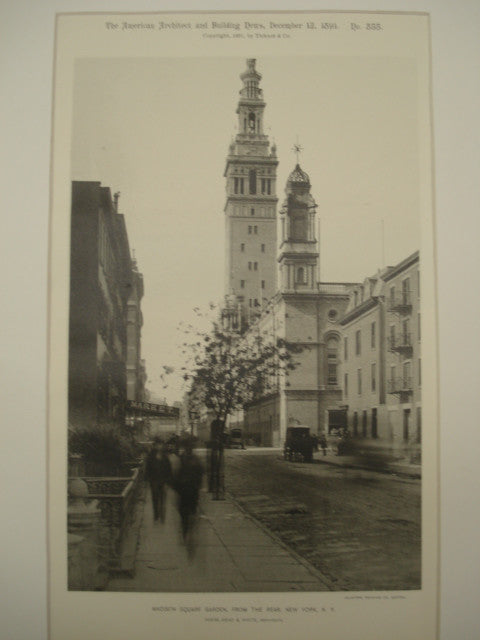
Welcome to the new St. Croix Architecture store! December 21 2013
We're very happy to welcome you to the new website for St. Croix Architecture. This comprehensive overhaul upgrades every aspect of our store with better searches, faster loading, more intuitive organization, and much much more. We are incredibly excited about the new site and its future possibilities, so please explore and enjoy!
Please feel free to contact us with any questions or comments.




